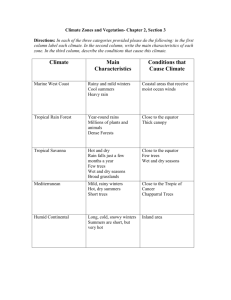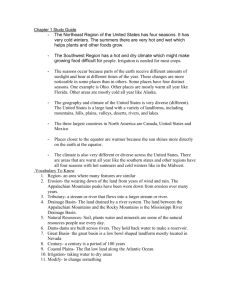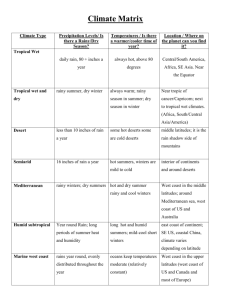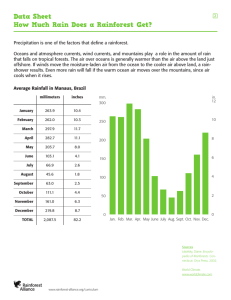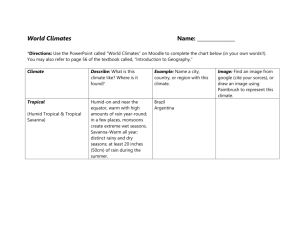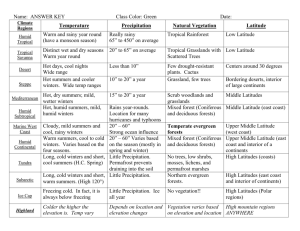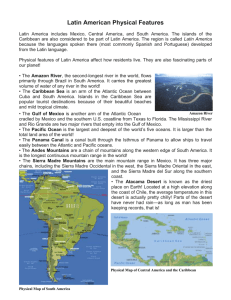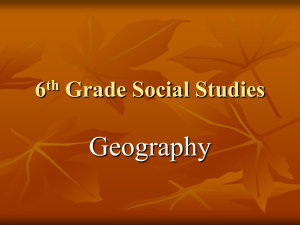Final Review Answers
advertisement
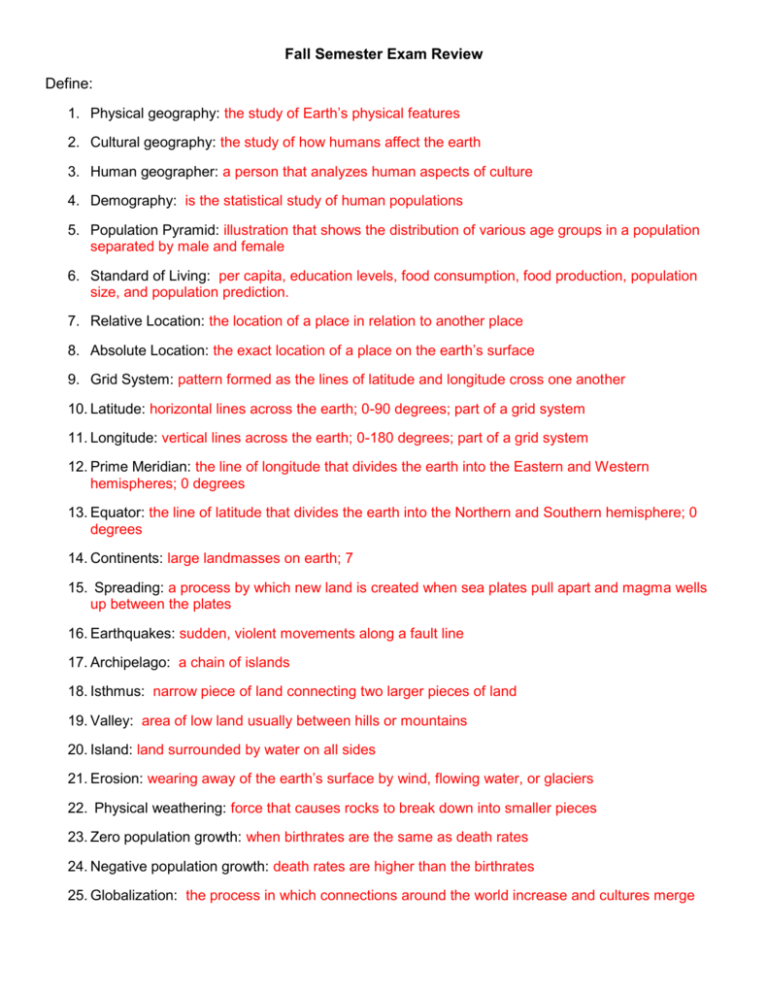
Fall Semester Exam Review Define: 1. Physical geography: the study of Earth’s physical features 2. Cultural geography: the study of how humans affect the earth 3. Human geographer: a person that analyzes human aspects of culture 4. Demography: is the statistical study of human populations 5. Population Pyramid: illustration that shows the distribution of various age groups in a population separated by male and female 6. Standard of Living: per capita, education levels, food consumption, food production, population size, and population prediction. 7. Relative Location: the location of a place in relation to another place 8. Absolute Location: the exact location of a place on the earth’s surface 9. Grid System: pattern formed as the lines of latitude and longitude cross one another 10. Latitude: horizontal lines across the earth; 0-90 degrees; part of a grid system 11. Longitude: vertical lines across the earth; 0-180 degrees; part of a grid system 12. Prime Meridian: the line of longitude that divides the earth into the Eastern and Western hemispheres; 0 degrees 13. Equator: the line of latitude that divides the earth into the Northern and Southern hemisphere; 0 degrees 14. Continents: large landmasses on earth; 7 15. Spreading: a process by which new land is created when sea plates pull apart and magma wells up between the plates 16. Earthquakes: sudden, violent movements along a fault line 17. Archipelago: a chain of islands 18. Isthmus: narrow piece of land connecting two larger pieces of land 19. Valley: area of low land usually between hills or mountains 20. Island: land surrounded by water on all sides 21. Erosion: wearing away of the earth’s surface by wind, flowing water, or glaciers 22. Physical weathering: force that causes rocks to break down into smaller pieces 23. Zero population growth: when birthrates are the same as death rates 24. Negative population growth: death rates are higher than the birthrates 25. Globalization: the process in which connections around the world increase and cultures merge 26. Traditionalism: cultures which follow longtime historical practices or ways of life and who sometimes oppose many modern innovations 27. Natural resources: substance from the earth that is not made by people but can be use by them 28. Renewable resources: resources that can be replenished and never run out 29. Nonrenewable resources: resources that can not be created and once they run out they are gone forever 30. Federal system: system of government that divides power between a national government and a state government 31. Command economy: system under which the government owns the means of production and distribution 32. Communism: society based on equality in which workers would control industrial production ex: Cuba 33. Republic: form of government without a monarch in which people elect their officials 34. Democracy: any system of government in which leaders rule with consent of the citizens 35. Monarchy: form of autocratic government; ruled by a king or queen that exercises the supreme powers of government 36. Absolute monarchy: king or queen with complete and unlimited power to rule their people 37. Oligarchy: system of government in which a small group hold power. Get power from wealth, military power, social position, or a combination of these elements 38. Bill of Rights: the first 10 amendments to the Constitution 39. Constitution: plan of government made for the United States 40. The Declaration of Independence: document declaring independence from British rule 41. Trade surplus: earning more money from export sales than spending for imports 42. Trade Deficit: spending more money on imports than earning from exports 43. Population density: the average number of people living in a square mile or square kilometer 44. Refugee: people who flee or are force to flee a country for their own safety. 45. Immigrant: a person moving into one country from another 46. Emigrant: a person leaving a country to move to another 47. Urbanization: the movement of people from rural areas to urban areas (country side to cities) 48. Humid Continental climate: northeastern US into southeastern Canada; cold winters (blizzards) and summers get cooler the farther north you are, and Europe 49. Marine West Coast climate: Pacific coast of US; 100+ inches of rain; cool summers and damp winters; 50. Humid Subtropical climate: long, muggy summers, mild winters; southeastern US; short, mild winters; year round rain 51. Steppe climate: dry areas, sparse plant life; often border deserts; dry, largely treeless grasslands; 10-20 inches of rain/year; hot summers, cool winters 52. Desert climate: dry areas, sparse plant life; less than 10 inches of rain/yr; hot days, cold nights 53. Tropical rainforest climate: Hawaii; hot and wet throughout the year; avg 80 degrees F.; 80+inches of rain/year; lush vegetation 54. Tropical savannah climate: Southern tip of Florida; dry winters, wet summers; high year round temperatures 55. Great divide: high point that determines which direction rivers flow; North America – Rocky Mountains; east of the Rockies flow to the Atlantic, Gulf of Mexico, Artic; west of the Rockies flow to the Pacific 56. Fall line: a boundary in the eastern US where the higher land of the Piedmont drops to the lower Atlantic coastal plain; waterfalls are common; used by many communities for power 57. Faults: cracks in the earth’s crust 58. Prairie: an inland grassland area (grasses can reach 12 feet high); common in the Great Plains 59. Timberline: elevation above which it is too cold for trees to grow 60. Tundra: climate zone closest to the polar regions; very cold; winter darkness and bitter cold last for half the year; indirect sun rays bring constant summer light but little heat; low bushes, very short grasses, mosses, and lichens 61. Rainshadow effect: dry area found on the leeward side of a mountain range; mountains block precipitation from falling in an area 62. Windward: facing toward the direction from which the wind is blowing; receives the most precipitation on a mountain 63. Leeward: facing away from the direction from which the wind is blowing; the side of a mountain opposite from windward 64. Atmosphere: a layer of gases that surrounds the earth; thins as elevation increases 65. Hydrosphere: the watery areas of the earth, including oceans, lakes, rivers, and other bodies of water 66. Lithosphere: surface land areas of the earth’s crust, including continents and ocean basins 67. Bioshphere: the part of the earth where life exist 68. Embargo: a ban on trade by one country with another 69. Tarrif: a tax on imports or exports 70. Textiles: cotton-based industry 71. Revolution: one rotation of the Earth around the sun; 365 days – 1 year 72. Rotation: one rotation of the Earth on its axis; 24 hrs – 1 day; causes day and night 73. Subsistence farming: producing just enough food for a family or a village to survive 74. Commercial farming: farming organized as a business 75. Timberline: point on a mountain which no vegetation grows past due to elevation 76. Surplus: excess amount 77. Deathrate: the number of deaths/year for every 1,000 people 78. Birthrate: the number of births/year for every 1,000 people 79. Tropic of Cancer: Line of latitude 33 degrees N; farthest point N that receives direct sunlight 80. Tropic of Capricorn: Line of latitude 33 degrees S; farthest point S that receives direct sunlight 81. Hemisphere: half of a sphere or globe, as in the earth’s Northern and Southern Hemispheres or Easter and Western hemispheres 82. Ecosystem: the complex community of interdependent living things in a given environment (plants and animals) 83. Solar System: the sun and planets around it 84. Tectonic plates: slabs of rock whose movement can create physical features 85. Mega city: city with more than 10 million people 86. Aquifer: underground water-bearing layers of porous rock, sand, or gravel 87. Weather: condition of the atmosphere in one place during a short period of time 88. Climate: weather patterns typical for an area over a long period of time 89. Global warming: gradual warming of the earth and its atmosphere that may be caused in part by pollution and an increase in the greenhouse effect 90. Smog: haze caused by the interaction of ultraviolet solar radiation with chemical fumes from automobile exhausts and other pollution sources 91. Less Developed Country: country in the process of becoming industrialized 92. Migration: the movement of people from place to place 93. Culture: way of life of a group of people who share beliefs and similar customs (language, religion, and history of a people) 94. Hurricane: a large, powerful windstorm that forms over warm ocean waters 95. Blizzard: a snowstorm with winds of more than 35 MPH, temperatures below freezing, and visibility of less than 500 feet for 3 hrs or more 96. Glacier: large, thick body of slowly moving ice 97. Tributary: smaller river or stream that feeds into a larger river 98. Headwaters: the sources of river waters 99. Mouth: end of a river (usually in a larger body of water) 100. Delta: alluvial deposit at a rivers mouth that looks like the Greek letter delta () 101. Bilingual: speaking or using 2 languages 102. Cordilleras: parallel chains or ranges of mountains 103. Pampas: grassy, treeless plains of southern South America 104. Estuary: an area where the tide meets a river current 105. Lake Maracaibo: in Venezuela contains rich deposits of oil 106. Amazon Basin: tropical climate because of prevailing wind patterns; contains the world’s largest rain forest 107. Amazon River: the Western Hemisphere’s longest river 108. Lake Titicaca: located in the Andes; the world’s highest navigable lake 109. Rio de la Plata: large estuary where 3 rivers meet the Atlantic Ocean 110. Patagonia: located at the southern end of South America 111. Latin America: (what makes up Latin America): Middle America, the Caribbean, and South America 112. Indigenous: native to a place 113. Maya: dominated southern Mexico and northern Central America; from a.d. 250 to a.d. 900; greatest city was Tikal (present day Guatemala); ruled by priests and nobles; economy based on agriculture and trade; skilled in mathematics; developed accurate calendars; used glyphs; abandoned cities for unknown reasons 114. Aztec: central Mexico; in the a.d. 1300’s; capital Tenochtitlan; grew beans and maize on chinampas; structured class system; ruled by an emperor and military officials 115. Inca: time of the Aztecs; est in the Andes mountains; stretched from Ecuador to central Chile; capital – Cuzco (present day Peru); ruled by an emperor; network of roads; terraces and irrigation systems; domesticated the alpaca and the llama; no written language; oral storytelling; used a quipu to keep track of financial records 116. Reforestation: replanting young trees or seeds on lands where trees have been cut or destroyed 117. Maquiladoras: foreign – owned factories 118. Push Factor: Something that would cause a person leave a place ex: Natural disaster, political oppression, economy 119. Pull factor: Something that would cause a person to go to a new place: job opportunities, good climate 120. NAFTA: North America Free Trade Agreement; between USA, Canada, and Mexico; reduces trade restrictions 121. Hydroelectricity: electricity generated from the energy of water 122. Dialect: a form of a language unique to a particular group 123. Ethnic religion (give ex): Focuses on one ethnic group and generally spreads into culture (Islam, Judaism) 124. Monotheistic: belief in one god 125. Polytheistic: belief in many gods 126. Nationalism: extreme feelings of pride and loyalty for ones own country 127. Patriotism: love for or devotion to one’s country 128. Terrorism: the use of violence to create fear in a given population 129. Infrastructure: all systems of transportation including roads, ports, highways 130. Peninsula: a stretch of land surrounded by water on three sides 131. Stalactite: dripping limestone-rich water which forms structures on the ceiling 132. Stalagmite: dripping limestone-rich water which forms structures on the ground 133. Who is the leading exporter of silver? Mexico 134. What are the 7 continents? Australia, Africa, Antarctica, Europe, Asia, South America, North America 135. What landform is the continent of Europe? Peninsula 136. What are low latitudes? Latitudes closest to the equator – warm temperatures 137. What are high latitudes? Latitudes closest to the poles – cold climate 138. What are the layers of the earth and the characteristics of each? Crust – thinnest layer (surface of the earth) Mantle- thick middle layer of the earth’s interior structure, consisting of dense, hot rock Core: Inner core – solid, hot Outer core – liquid, hot 139. Where is the Amazon located and what is significant about it? In South America, it is the largest (by volume) river in the world 140. What is the population of Paris? 7 Million 141. Where is the Death Valley and what is significant about it? Located in California; lowest point in the US and the highest temperature in the US 142. What are everglades and where can you find them? Florida; area of wetlands and swamps 143. What do TODALSIGS stand for? Title Orientation Date Author Legend Scale Index Grid System Source 144. How much of the earth’s surface is covered by land? By water? How much of that is freshwater? 30%; 70%; 3% 145. Where is Mt. Everest and why is it significant? Highest point on earth; Himalaya 146. Be able to explain the steps of the water cycle. Maintains a consistent amount Evaporation: changing of a liquid into a gas Condensation: the process of excess water vapor changing into liquid water when warm air cools Precipitation: moisture that falls to the earth as rain, sleet, hail, or snow 147. Name 4 major types of landforms. Mountains, hills, plateaus, and plains 148. What is the Mariana Trench, where is it, why is it significant? Deepest known depression on Earth; Pacific Ocean 149. Name the 8 planets. Jupiter, Saturn, Neptune, Uranus, Mercury, Venus, Earth, Mars a. Which are terrestrial planets? Mercury, Venus, Earth, Mars b. Which are gaseous planets? Jupiter, Saturn, Neptune, Uranus 150. What are the characteristics of a highlands climate? Extremely cold a. Where would you find it? High elevation 151. How does elevation affect climate? Higher the elevation the colder the climate 152. How does latitude affect climate? High latitudes (closer to the poles) have a colder climate; lower latitudes (closer to the Equator) have warmer climates 153. What is an equinox? One of two days (march 21 and September 23) on which the sun is directly above the Equator, making day and night equal in length a. When do equinoxes take place? March and September 154. What would the natural vegetation be in a desert? Scattered shrubs and cacti 155. What causes seasons? The earth’s revolution and its tilt in relation to the sun 156. What affects temperatures on the earth? The earth’s position in relation to the sun 157. Why must countries trade with each other? Natural resources are distributed unevenly among countries 158. How is the world’s population distributed? Unevenly distributed 159. What makes up a culture? Language, religion, social groups, government, and economic activities 160. What are the 3 factors that change cultures? War, trade, migration 161. What makes up an ethnic group? Group of people that have a common language, history, and place of origin 162. What climate would you find in Hawaii? Tropical 163. Which type of North American landform are rich coal and mineral deposits generally found? Mountain ranges 164. What do scientists believe about the earth’s continents? That they were once joined in a massive super-continent called Pangaea and have spread due to continental shifting 165. What occurs when a river is dammed? The river expands upstream creating a lake 166. Why would a dam be built? Flood control, hydroelectricity, recreation 167. What role did glaciers play in forming the Great Lakes? Glaciers carved basins out of bedrock 168. What happens at the poles during summer and winter? Constant sunlight (indirect) during summer and no sunlight during winter 169. When did the USA declare independence? From whom? 1776, Great Britain 170. Why did Europeans set up colonies in Latin America? Europeans set up colonies in Latin America to gain wealth for their home countries 171. Where are the Andes mountains? Western coast of South America; world’s longest mountain range 172. Where is the Atacama Desert and what is significant about it? Chile; One of the driest places in the world; created by the rain shadow effect 173. When did most Latin American countries gain their independence? The 1800’s 174. What was the official religion of the Spanish colonists? Catholicism 175. What language is spoken in Brazil? Portuguese Haiti? French Bahamas? English Mexico? Spanish 176. Name the indigenous Latin American empires. Maya, Aztec, and Inca 177. What was the first Latin American country to gain its independence. Haiti from France 178. Where can you find the Straight of Magellan? Very southern tip of South America 179. What is the Panama Canal and what is significant about it? Man made canal in Panama that connects the Pacific and Atlantic Oceans. Allows for much shorter trade routes. Controlled by the USA until 1999, now controlled by Panama 180. What is the largest country in the world? Russia 181. How many languages are spoken in Europe? About 50 182. Where are the Pyrenees mountains located? Between Spain and France 183. Name the 3 main crops grown in Europe. Grapes, olives, and potatoes 184. Why does Europe have such a diverse culture? Migration, cultural diffusion, and changing political borders 185. Ring of Fire: Area around the Pacific Ocean that is known for having frequent earthquakes and numerous volcanoes as a result of the high plate activity 186. Functional Region: a city 187. Formal Region: a region with a specific, defined border 188. Fujita Scale: used to measure the intensity of tornadoes 1-5 189. Richter Scale: used to measure the intensity of earthquakes 1-10 190. What was significant about Chernobyl? It demonstrated the dangerousness of nuclear power plants, the long term effects of a disaster like this, and demonstrated transboundary pollution. Similar to the disaster in Japan in 2008 191. Puerto Rico: A territory of the United States, citizens of PR are also citizens of the USA but are not allowed to vote in presidential elections. 192. What makes up the United Kingdom? Northern Ireland, England, Wales, Scotland ** Be sure you review your maps and know the relative location of significant places: Iberian peninsula, Italy, Scandinavian Peninsula (what countries make up this area), Strait of Gibraltar, English Channel, Russia, location of all continents, Canada, Mexico, the USA, Hispanola, Haiti, Dominican Republic, Cuba, Panama. The capitals of the following countries: France, USA, Canada, Mexico, Germany, Spain, Russia, UK, Bolivia, Brazil, Panama, Italy, and Greece

